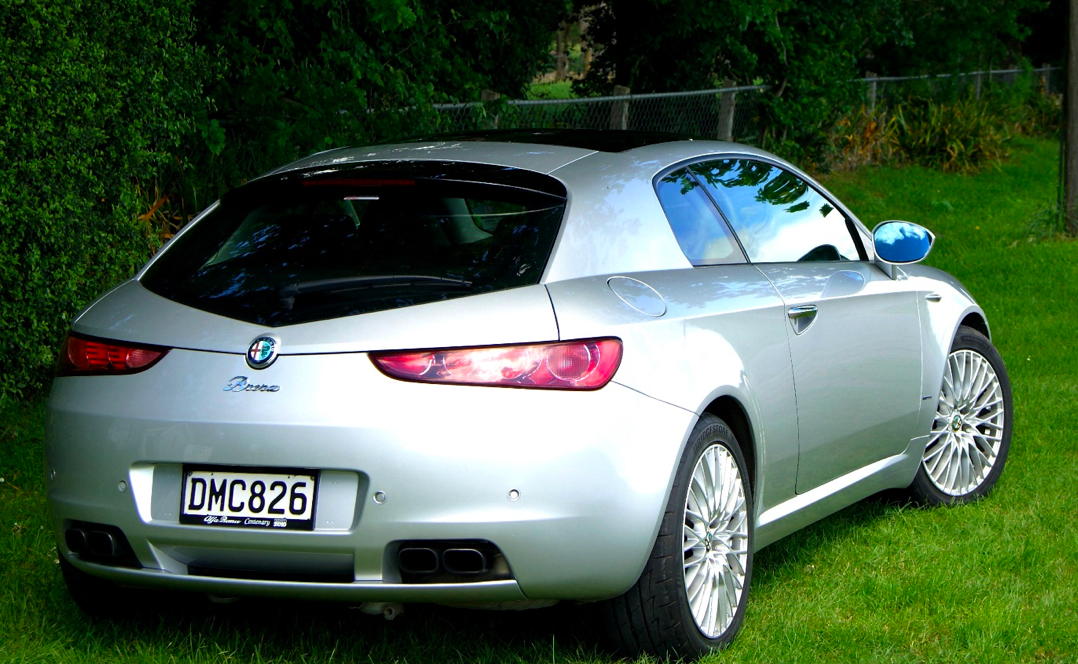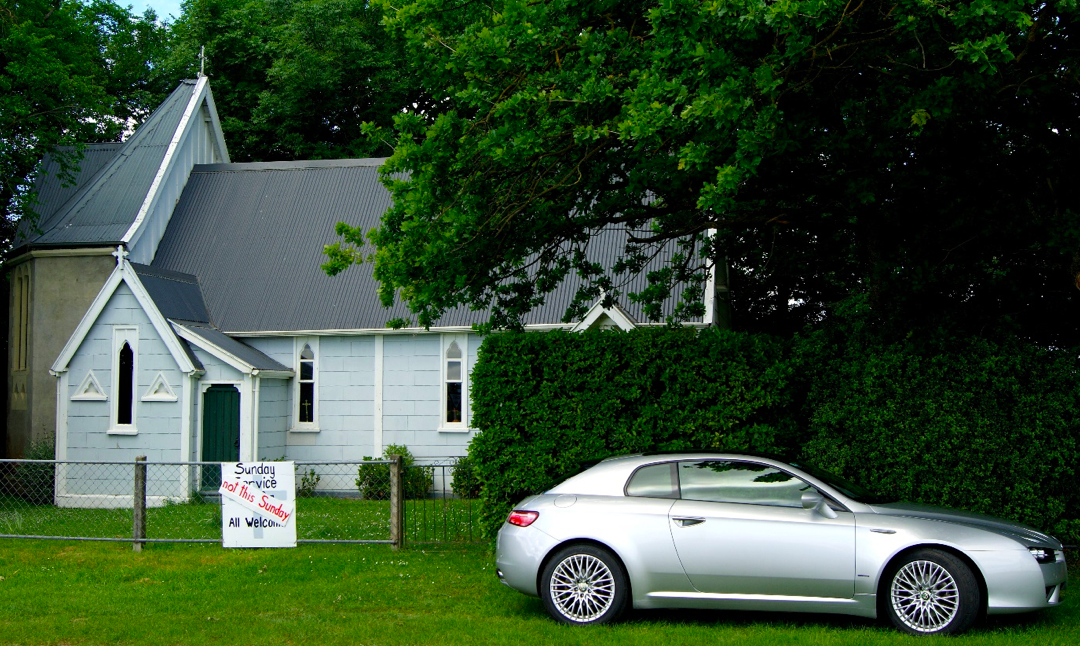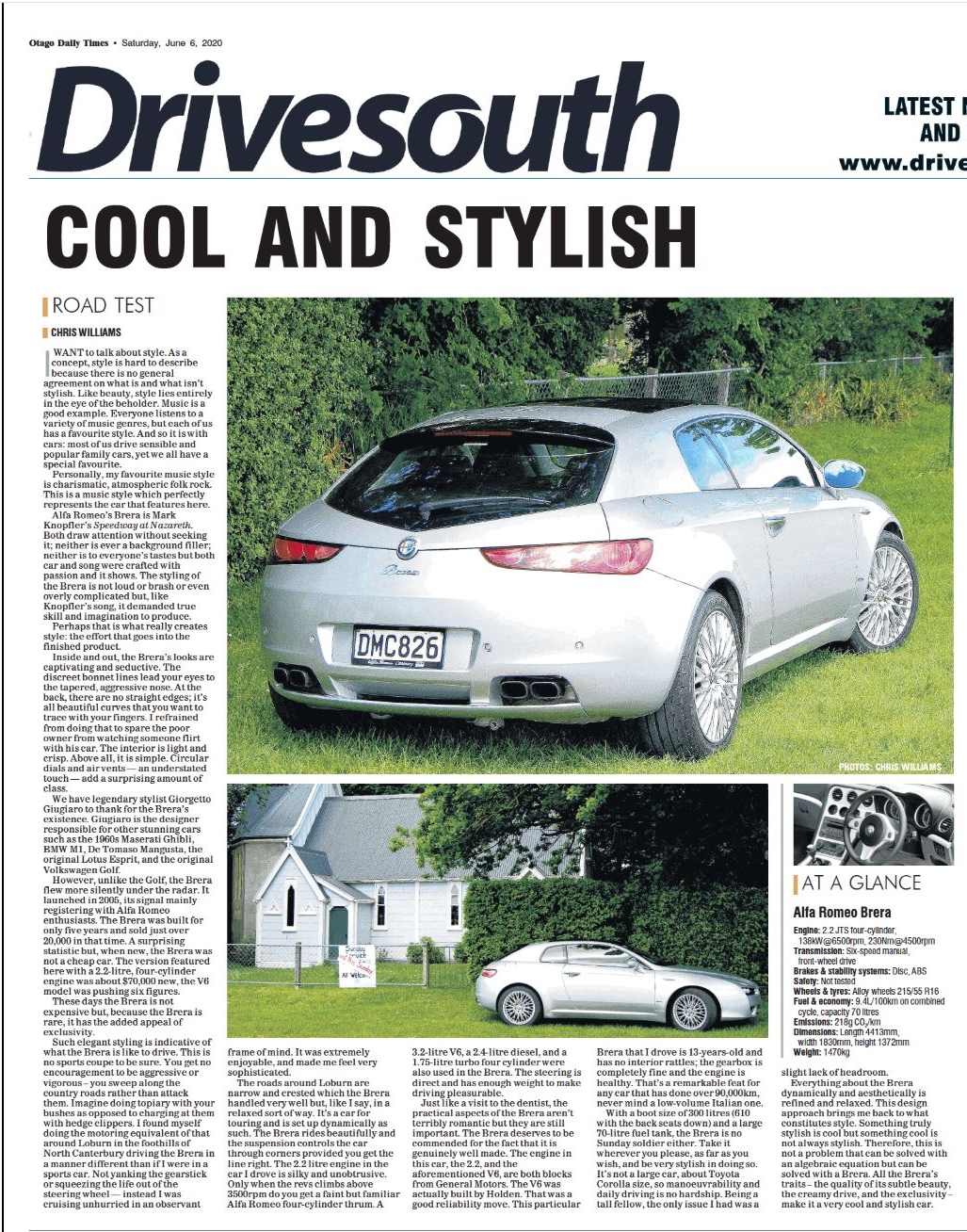I want to talk about style. As a concept, style is hard to describe because there is no general agreement on what is and what isn’t stylish. Like beauty, style lies entirely in the eye of the beholder. Music is a good example. Everyone listens to a variety of music genres, but each of us has a favourite style. And so it is with cars: most of us drive sensible and popular family cars, yet we all have a special favourite.
Personally, my favourite music style is charismatic, atmospheric folk rock. This is a music style which perfectly represents the car that features here.
Alfa Romeo’s Brera is Mark Knopfler’s Speedway at Nazareth. Both draw attention without seeking it; neither are ever a background filler; neither are to everyone’s tastes but both car and song were crafted with passion and it shows. The styling of the Brera is not loud or brash or even overly complicated but, like Knopfler’s song, it demanded true skill and imagination to produce.
Perhaps that is what really creates style: the effort that goes into the finished product.
Inside and out the Brera’s looks are captivating and seductive. The discreet bonnet lines lead your eyes to the tapered, aggressive nose. At the back, there are no straight edges; it’s all beautiful curves that you want to trace with your fingers. I refrained from doing that to spare the poor owner from watching someone flirt with his car. The interior is light and crisp. Above all, it is simple. Circular dials and air vents – an understated touch – add a surprising amount of class.
We have legendary stylist Giorgetto Giugiaro to thank for the Brera’s existence. Giugiaro is the designer responsible for other stunning cars including the 1960s Maserati Ghibli, BMW M1, De Tomaso Mangusta, the original Lotus Esprit, and the original Volkswagen Golf.
However, unlike the Golf, the Brera flew more silently under the radar. It launched in 2005, its signal mainly registering with Alfa Romeo enthusiasts. The Brera was only built for five years and sold just over 20,000 in that time. A surprising statistic but, when new, the Brera was not a cheap car. The version featured here with a 2.2 litre four-cylinder engine was about $70,000 new, the V6 model was pushing six figures.
These days the Brera is not expensive but because the Brera is rare, it has the added appeal of exclusivity.
Such elegant styling is indicative of what the Brera is like to drive. This is no sports coupé to be sure. You get no encouragement to be aggressive or vigorous – you sweep along the country roads rather than attack them. Imagine doing topiary with your bushes as opposed to charging at them with hedge clippers. I found myself doing the motoring equivalent of that around Loburn in the foothills of North Canterbury driving the Brera in manner different than if I were in a sports car. Not yanking the gearstick or squeezing the life out of the steering wheel. instead I was cruising unhurried in an observant frame of mind. It was extremely enjoyable, and made me feel very sophisticated.
The roads around Loburn are narrow and crested which the Brera handled very well but, like I say, in a relaxed sort of way. It’s a car for touring and is set up dynamically as such. The Brera rides beautifully and the suspension controls the car through corners provided you get the line right. The 2.2 litre engine in the car I drove is silky and unobtrusive. Only when the revs climb above 3500 rpm do you get a faint but familiar Alfa Romeo four-cylinder thrum. A 3.2 litre V6, a 2.4 litre diesel, and a 1.75 litre turbo four cylinder were also used in the Brera. The steering is direct and has enough weight to make driving pleasurable.
Just like a visit to the dentist, the practical aspects of the Brera aren’t terribly romantic but they are still important. The Brera deserves to be commended for the fact that it is genuinely well made. The engine in this car, the 2.2, and the aforementioned V6 are both blocks from General Motors. The V6 was actually built by Holden. That was a good reliability move. This particular Brera that I drove is thirteen years old and has no interior rattles; the gearbox is completely fine and the engine is healthy. That’s a remarkable feat for any car that has done over 90,000 kilometres, never mind a low-volume Italian one.
With a boot size of 300 litres (610 with the back seats down) and a large 70 litre fuel tank, the Brera is no Sunday soldier either. Take it wherever you please, as far as you wish, and be very stylish in doing so. It’s not a large car, about Toyota Corolla size, so manoeuvrability and daily driving is no hardship. Being a tall fellow, the only issue I had was a slight lack of headroom.
Everything about the Brera dynamically and aesthetically is refined and relaxed. This design approach brings me back to what constitutes style. Something truly stylish is cool but something cool is not always stylish. Therefore, this is not a problem that can be solved with an algebraic equation but can be solved with a Brera. All the Brera’s traits – the quality of its subtle beauty, the creamy drive, and the exclusivity – make it a very cool and stylish car.
Engine: 2.2 JTS four-cylinder, 138kW@6500rpm, 230Nm@4500rpm
Transmission: Six-speed manual, front wheel drive
Brakes and stability systems: Disc, ABS
Safety: Not tested
Wheels and Tyres: Alloy wheels 215/55 R16
Fuel and economy: 9.4 litres per 100km on combined cycle, tank capacity 70 litres
Emissions: 218g CO2/km
Dimensions: Length 4413mm, width 1830mm, height 1372mm; Weight: 1470kg




